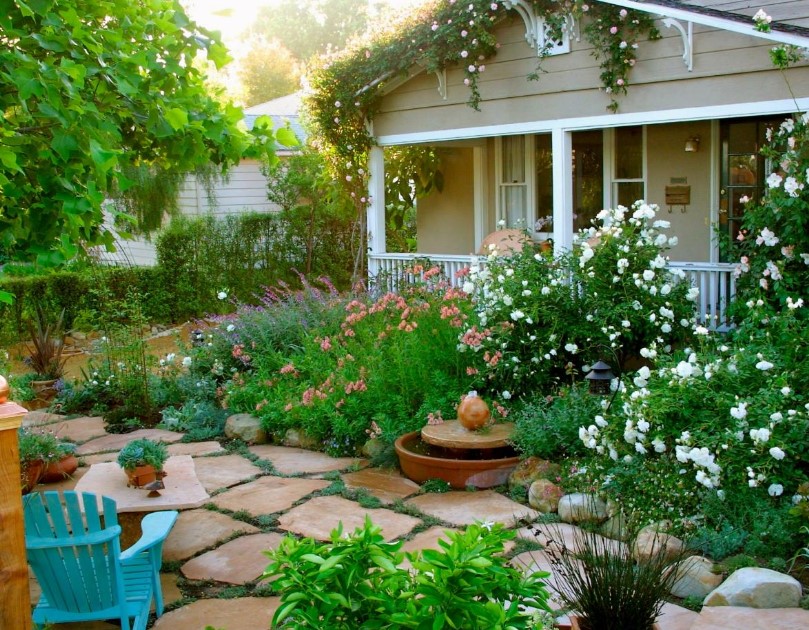Few styles in landscape design evoke the same sense of nostalgia and charm as the cottage garden. Originating in rural England centuries ago, these gardens have captivated hearts with their informal, romantic beauty. Characterized by a lush mix of flowers, herbs, and vegetables, cottage gardens offer a delightful blend of functionality and aesthetics.
The History of Cottage Gardens:
To truly appreciate the allure of cottage gardens, one must journey back to their humble beginnings. Emerging in medieval England, these gardens served as a source of sustenance for cottage dwellers, who cultivated herbs, vegetables, and flowers in the limited space surrounding their homes. Unlike the formal gardens of aristocracy, cottage gardens embraced a more relaxed approach to planting, emphasizing practicality and productivity over rigid symmetry.
Principles of Cottage Garden Design:
At the heart of cottage garden design lies a set of guiding principles that have stood the test of time:
- Cottage gardens prioritize diversity, with a rich tapestry of plants coexisting harmoniously to create a vibrant ecosystem.
- They embrace a naturalistic aesthetic, with plants allowed to sprawl and intermingle freely, evoking a sense of wild beauty.
- Cottage gardens embody the “right plant, right place,” with species selected based on their adaptability to local climate and soil conditions.
Elements of Cottage Garden Style:
Certain key elements come to mind when envisioning a cottage garden, each contributing to its distinctively charming appeal. One such element is the use of heirloom varieties and cottage garden classics, such as lavender, roses, and delphiniums, which infuse the space with timeless elegance. Another hallmark of cottage garden style is incorporating structural elements, such as picket fences, arbors, and rustic pathways, which add visual interest and define the garden’s boundaries.
Creative Cottage Garden Design Ideas:
Now, let’s explore a myriad of creative ideas to bring the enchanting allure of cottage gardens to life in your own outdoor space.
Embrace a Cottage Garden Color Palette:
- One of the most captivating aspects of cottage gardens is their riotous explosion of color. To emulate this vibrant aesthetic, consider selecting plants in a harmonious color palette, such as soft pastels or bold jewel tones. Mix and match flowers with varying bloom times to ensure year-round visual interest, and don’t shy away from incorporating foliage plants for added texture and depth.
Create Intimate Garden Rooms:
- Cottage gardens often feature secluded nooks and hidden corners that invite exploration and contemplation. To recreate this sense of intimacy in your garden, divide the space into distinct “rooms” using trellises, hedges, or strategically placed plantings. Each area can serve a different purpose: a tranquil seating area, a fragrant herb garden, or a whimsical children’s play area.
Incorporate Vertical Gardening:
- Maximize limited space in your cottage garden by embracing vertical gardening techniques. Install trellises, pergolas, or espaliered fruit trees to create vertical interest and support climbing plants such as roses, clematis, and jasmine. Hanging baskets and wall-mounted planters offer additional opportunities to add greenery and floral accents to walls, fences, and other vertical surfaces.
Integrate Edible Plants:
- Stay true to the practical origins of cottage gardens by incorporating edible plants alongside ornamentals. Herbs like thyme, sage, and rosemary add fragrance and visual appeal and serve culinary purposes in the kitchen. Mix vegetables and fruits such as tomatoes, beans, and strawberries to create a bountiful harvest that nourishes both body and soul.
Embrace Cottage Garden Maintenance Techniques:
- While cottage gardens exude a carefree charm, they still require regular maintenance. Embrace organic gardening practices such as mulching, composting, and hand weeding to promote soil health and minimize reliance on synthetic fertilizers and pesticides. Deadheading spent blooms and dividing overcrowded perennials will ensure continuous flowering and prevent the garden from becoming overgrown.
Conclusion:
In conclusion, cottage gardens represent a timeless embodiment of rustic beauty and botanical abundance. Understanding the history, principles, and creative ideas behind cottage garden design allows you to embark on a journey to create your slice of paradise. Whether you have a sprawling estate or a compact urban plot, the principles of cottage gardening can be adapted to suit any space, allowing you to cultivate a garden that delights the senses and nourishes the soul for years to come.

